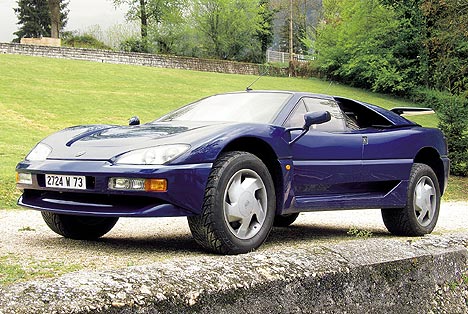1992-1995 Mega Track
- Story Cars

- Sep 26, 2022
- 4 min read
After World War II, the hungry French auto industry switched from luxury chariots like Bugatti and Delage to unpretentious microcars, most often four-wheeled covered motorcycles. Only auto giants Renault/Peugeot/Citroen could afford something more (and even those mainly focused on small hatchbacks, which are still popular today) and single upstarts like Facel.
Gradually, France regained its former pre-war glory, not least with the expressive cars of Citroen, as well as the racing successes of Renault, Peugeot, and Alpine. But the love for microcars has already been absorbed. Moreover, in the mid-seventies, some manufacturers like Arola began to produce miniature cars that did not require a driver's license - and what else do romantic and carefree French people need?
By the mid-1980s, Arola went bankrupt, and it was bought out for nothing by businessman and entrepreneur Georges Blain, who founded Aixam on the wreckage of Arola. The latter, under able leadership, became the leading manufacturer of "voiture sans permis" microcars (the ones that didn't require a license - only 14 years of age and no prohibitive medical orders) and remained so to this day. However, this was not enough for the ambitious Monsieur Blaine.
However, car maniacs will never forget her thanks to the Track model, which to this day is unparalleled. In 1992, the entrepreneur registered the trademark Mega. Over time, the team under this brand will win the 1994-1995 season in the Andros Trophy championship and create an interesting Monte-Carlo supercar with the support of Mobil and Michelin.
The speaking brand Mega was registered for this particular car. The idea of an off-road supercar, which neither Lamborghini, Ferrari, nor Porsche had, Georges Blain had been hatching for a long time, but within the Aixam brand, which produces only small-capacity microcars, such a car would look ridiculous. Thanks to the designer Philip Colanson's engineering genius and the valuable advice of the rally driver Bernard Darnish, who also fit into the Mega Track project, the idea quickly acquired its physical appearance. And already at the Paris Motor Show in 1992, the newly minted car of the newly minted company made its debut ... and became a real show-stopper.
The long (about 5 meters), wide (2.5 meters) mid-engined coupe had the proportions of a classic supercar of the period. The only thing that didn't fit in my head was the enormous 20-inch wheels (the Lamborghini Diablo had, for example, 18-inch ones) and the blatant ground clearance. In those years, supercars already liked to strike the bottom of any bump, so 220 millimeters of Mega Track seemed like something crazy. But the air suspension made it possible to increase the ground clearance up to 300 millimeters ...
The first production road car produced by Mega was the Track. A four-seater saloon was a 12-cylinder engine. It used the Mercedes V12, delivering 394 horsepower to all four wheels. Technically, the car was more or less similar to most supercars of that time: it was based on a spatial tubular frame, and the suspension was on double triangular levers behind riders' backs (attention!) A unique feature of the Track was its adjustable ride height. The car raised its clearance from eight to thirteen inches at full size!
In the case of the Mega Track, the engine was a six-liter - from the Mercedes W140, as was the automatic transmission. At the same time, Mega engineers had to develop an all-wheel drive system on their own since all-wheel drive S-Classes did not exist then. The French also gave trouble to the engine cooling system, which had to be re-created using four electric fans.
Despite the mass of more than two tons, Mega Track had quite supercar dynamics: acceleration to "hundreds" took about 6 seconds, and the maximum speed reached 250 kilometers per hour. Moreover, the car did not need a road as flat as a table to get these indicators, which favorably distinguished it from its competitors. Instead, from other supercars. After all, Mega Track had no direct competitors. At the same time, the interior had armchairs with high-quality leather upholstery and electrical adjustments, air conditioning, an excellent audio system, and other benefits of that era.
It would seem that the car is doomed to success because after the auto show, there was only talk about the new French supercar - millionaires stood with checkbooks at the ready in the hope of getting the Mega Track before the rest. However, when its debut, Mega did not have production lines to produce such a complex car on a more or less industrial scale. In addition, Mega Track required sea trials and perfection of quality - Blain could not allow otherwise. As a result, five copies (according to other sources - 11) were released only in 1995, when many had time to forget about the car.
Each copy of Mega Track sold cost about 400 thousand dollars, but even these prices could not cover the costs of its creation and production. After trying his luck later with the more traditional Mega Monte Carlo sports coupe, Georges Blain gave up trying to conquer the world of supercars, and Mega quietly entered Aixam. By the way, a rather brutal supercar fell in love with the mysterious "Russian soul," so the lion's share of these cars ended up in Russia, where they are today. You can see Mega Track in the film Duhless or the clip of Timati and Guf. Could everything be different? Of course. But history and the subjunctive mood are incompatible things.
Only five examples of the Track were completed before a new, the more exciting product took its place: the Mega Monte Carlo.
Source: Alexey Olefirenko - motor.ru
Images: Mega






























































Comments